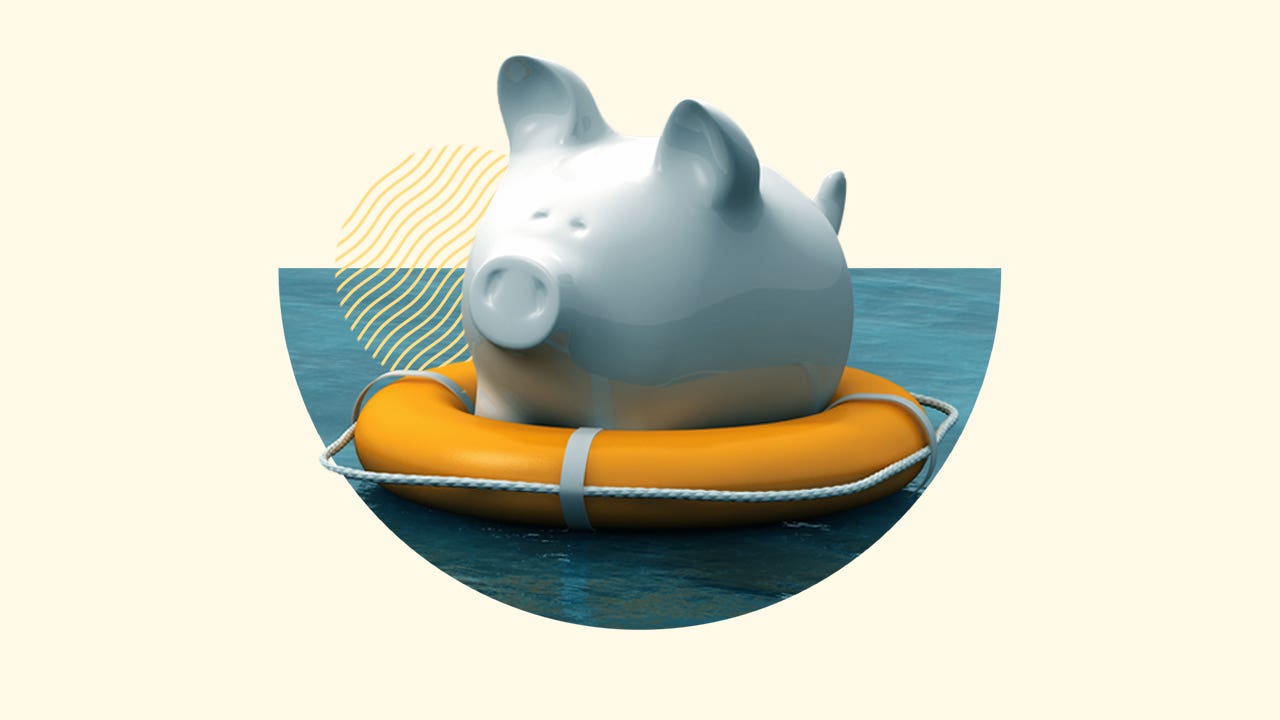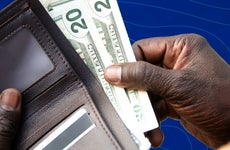Survey: 81% of Americans didn’t increase their emergency savings this year as majority feels behind

The Bankrate promise
At Bankrate we strive to help you make smarter financial decisions. While we adhere to strict , this post may contain references to products from our partners. Here's an explanation for .
Around four in five households haven’t increased their emergency savings in 2023, at a time when most Americans feel they’re behind where they should be in saving for emergencies, a new Bankrate survey found — and inflation continues to be the main obstacle that’s preventing people from saving money.
The data was collected by polling roughly 2,500 U.S. adults in September regarding their level of emergency savings and whether they feel on track with the amount they have set aside.
Despite 60 percent of all Americans feeling behind on their emergency savings, just 19 percent have increased their emergency savings balances since the beginning of the year. Rising prices and high household expenses have been the predominant impediments to boosting emergency savings.— GREG MCBRIDE | BANKRATE CHIEF FINANCIAL ANALYST
Key emergency fund insights
- Many have less emergency savings now than at the start of 2023. Nearly one-third of households (32 percent) have less emergency savings now than at the start of the year.
- Inflation and having too many expenses are to blame. More than half (57 percent) of those who haven’t boosted their emergency savings or have no such savings say inflation is keeping them from saving more right now, while 38 percent say the reason they’ve not increased savings is they have too many expenses.
- Most Americans feel they’re behind on emergency savings. More than half of Americans (60 percent) say they’re behind where they should be when it comes to emergency savings. This is composed of 38 percent who say they’re significantly behind and 22 percent who say they’re slightly behind.
- Many who are behind on emergency savings don’t think they’ll be back on track soon, or ever. Nearly one in five (16 percent) of those who are behind on emergency savings believe their emergency savings will be on track in more than five years, while 13 percent feel their savings will never be on track and 22 percent don’t know how long it’ll take.
Just 1 in 5 households has increased their emergency savings since the start of 2023
Nearly one in five households (19 percent) has increased their emergency savings since the beginning of the year, while almost one-third of households (32 percent) have less emergency savings now than at the start of 2023 — including 14 percent that have somewhat less savings now and 17 percent that have much less savings now than at the beginning of the year. Nearly one-third of households (30 percent) have about the same amount, and 20 percent had no emergency savings at the beginning of the year, and still have none.
Note: Not all percentages in the chart add to 100 due to rounding, and percentages in the text may differ from the chart due to rounding for categories.
Source: Bankrate survey, September 20-22, 2023
When it comes to age, older generations are more likely than younger ones to have less emergency savings now when compared to the start of 2023, as follows:
- Gen X households are three times as likely to have less emergency savings now (39 percent) rather than more (13 percent), and baby boomers are more than twice as likely to have less now (36 percent) rather than more (15 percent), when compared to the beginning of the year.
- By contrast, Gen Zers (22 percent more, 21 percent less) and millennials (29 percent more, 27 percent less) were actually slightly more likely to have more, rather than less, emergency savings compared to the start of the year.
The percentage of households that have more or less emergency savings now than at the beginning of the year isn’t appreciably different among income groups that earn less than $100,000 annually. Only households earning at least $100,000 were more likely to have more, rather than less, emergency savings now compared to the start of the year. What’s more, the likelihood of having no emergency savings either now or at the beginning of 2023 decreases as household income increases.
| Income bracket | Percentage with less emergency savings now than at start of 2023 | Percentage with more emergency savings now than at start of 2023 | % with no emergency savings either now or at start of 2023 |
|---|---|---|---|
| Under $50,000 a year | 33% | 17% | 27% |
| $50,000-$79,999 | 33% | 18% | 16% |
| $80,000-$99,999 | 36% | 20% | 6% |
| $100,000 or more | 27% | 30% | 4% |
College graduates with a four-year undergraduate degree or higher (26 percent) are more likely than those without a 4-year college degree (17 percent) to have added to their emergency savings since the start of the year.
57 percent of households that haven’t increased emergency savings this year cite inflation as the reason
The top reason Americans haven’t increased their savings this year is inflation, cited by 57 percent of all households that have not increased their emergency savings or have no emergency savings, as well as 73 percent of those that have less savings now.
The second most commonly cited reason was having too many expenses, which was cited by 38 percent of all households that haven’t increased their emergency savings or have no emergency savings, as well as 44 percent of those that have less savings now.
Other reasons cited, but far less frequently, were having too much debt (21 percent), changes in income/employment (18 percent), rising interest rates (17 percent), encountering a big emergency expense (13 percent), too much discretionary/leisure spending (8 percent), and something else (6 percent). Respondents could select more than one reason.
*Of U.S. adults who have not increased their emergency savings or have no emergency savings
Source: Bankrate survey, September 20-22, 2023
Of households that have not increased their emergency savings, nearly one in five (17 percent) said they’re comfortable with the emergency savings they currently have and this is why they haven’t added to their balances this year.
Among generations, Gen Xers (62 percent) and baby boomers (61 percent) who haven’t increased their emergency savings were more likely to point to inflation as the culprit than were millennials (56 percent) and Gen Zers (40 percent).
Across income groups, inflation was the most-cited reason as an impediment to increasing emergency savings. It was most commonly cited among households earning $80,000-$99,999 (69 percent), followed by those earning 50,000-$79,999 (62 percent), those earning under $50,000 (58 percent), and those earning $100,000 or more (47 percent).
60 percent of Americans say they’re behind on emergency savings
More than half of Americans (60 percent) say they’re behind on their emergency savings, made up of 38 percent who feel significantly behind and 22 percent who feel slightly behind. Just 22 percent feel they’re right on track, while 18 percent feel they’re ahead of where they should be — including 11 percent who feel slightly ahead and 7 percent who feel significantly ahead.
Source: Bankrate survey, September 20-22, 2023
Among those who currently have some level of emergency savings:
- 55 percent say they’re behind where they should be. This includes:
- 30 percent who feel they’re significantly behind
- 25 percent who feel slightly behind
- 21 percent feel they’re ahead of where they should be. This includes:
- 13 percent who feel slightly ahead
- 8 percent who feel significantly ahead
- Just 24 percent of those with some emergency savings feel they’re right on track.
When it comes to how different generations feel about their level of emergency savings:
- Gen Xers (72 percent) and baby boomers (65 percent) are more likely than millennials (54 percent) and Gen Z (44 percent) to feel as though they’re behind on emergency savings.
- Gen Xers (11 percent) and baby boomers (13 percent) are less likely than millennials (24 percent) and Gen Zers (23 percent) to say they’re ahead of where they should be.
The feelings of being ahead or behind on emergency savings break down similarly among households earning less than $100,000 per year, while even those earning $100,000 or above were somewhat more likely to feel behind, follows:
| Income level | % who feel behind | % who feel ahead |
|---|---|---|
| Under $50,000 | 66% | 15% |
| $50,000-$79,9999 | 63% | 13% |
| $80,000-$99,999 | 58% | 18% |
| $100,000 and above | 42% | 32% |
Among those who have less savings now than at the beginning of the year:
- 88 percent feel behind on their emergency savings.
- 6 percent feel ahead on their emergency savings.
- 6 percent feel right on track with their emergency savings.
Of those who are behind on emergency savings, 13 percent say they’ll never get back on track, and 22 percent don’t know how long it’ll take
Of those who feel behind where they should be in regard to their emergency savings, a significant portion either felt they’ll never save enough to feel on track (13 percent) or said they didn’t know how long it’ll take (22 percent).
Others provided a timeframe for when they thought they’d feel back on track, with 8 percent who thought it’ll be in less than a year, 31 percent who predicted 1-3 years from now, 10 percent who thought it would be 4-5 years from now and 16 percent who said it would be in more than five years.
* Of U.S. adults who think they are behind where they should be in regard to their emergency savings
Source: Bankrate survey, September 20-22, 2023
Among generations, Gen Xers (42 percent) and baby boomers (42 percent) who feel behind on their savings are more likely to say it’ll take at least four years to get back on track (or that they never will) with emergency savings, compared to 36 percent of millennials and 31 percent of Gen Zers.
3 ways to boost your emergency fund
If you’re behind on your emergency savings, the good news is there are various things you can do now to help turn things around. Places to start include opening a high-yield savings account, as well as finding ways to cut your spending and increase your income.
1. Open a high-yield savings account
Not all savings accounts are created equal, so it pays to shop around for the best yield. These days, high-yield savings accounts are earning rates that are many times the national average — and that are outpacing the rate of inflation.
Online-only banks are commonly where you’ll find the highest-yielding accounts, and these banks are also known for their low minimum balance requirements and lack of fees.
It often helps to keep your emergency fund separate from other savings. You can do so by keeping a dedicated account just for emergency savings, or by finding a savings account that lets you allocate portions of your money toward different goals.
2. Cut back on spending
Take inventory of where your money is going every month, and you’ll likely find dozens of areas where you can cut spending. Various ways to trim your budget include:
- Preparing more of your meals at home
- Shopping around for lower insurance rates
- Canceling subscriptions and streaming services you don’t use
- Taking fewer vacations (or more affordable ones)
- Avoiding impulse purchases by turning off notifications from shopping apps
- Holding off on buying a new vehicle if yours is still in good condition
- Learning how to change your own oil
- Having a grab bag or Secret Santa gift exchange for the holidays, rather than buying a present for every single friend or family member
One way you can find ways to reduce spending is creating a monthly budget, which allows you to plan for how you’ll spend your money. Be sure to include a line item in your budget for money to add to your emergency fund.
3. Start a side hustle
A side hustle is a way of earning money in addition to your main job, and the cash you make can help boost your emergency savings. The best side hustle is often one that utilizes your skills or talents — and involves work that you enjoy. Common side hustles include:
- Tutoring
- Pet sitting
- Dog walking
- Speaking engagements
- Freelance writing or designing
- Life coaching
In fact, nearly two in five U.S. adults have a side hustle — and the average person with a side hustle earns $810 per month from it, a recent Bankrate survey found. One quarter (25 percent) of these side hustlers said they devote the extra income to savings.
“Cutting household expenses in a meaningful way may not be feasible with the run-up in prices for mainstay items such as shelter, food, and energy over the past couple of years,” Bankrate’s McBride says. “Consider tapping into the tight labor market with a side hustle, freelance or contract work, or even taking on a second job for a period of time in order to make headway on boosting savings.”
Frequently asked questions
-
An emergency fund can be used for unplanned expenses, such as home or car repairs, a medical bill or a sudden job loss. It’s not a good idea to use the money in your emergency fund for vacations, entertainment or other things that aren’t necessities.
-
Without an emergency fund, you may need to cover unplanned expenses by going into credit card debt, borrowing money from family or friends, or taking money that’s set aside for other bills.
-
Experts say you should have enough money in your emergency fund to cover three to six months’ worth of living expenses. This will help keep you from going into debt to pay for an unexpected car repair or medical bill, or if you were to lose your job.
Methodology
All figures, unless otherwise stated, are from YouGov Plc. Total sample size was 2496 adults. Fieldwork was undertaken between 20th – 22nd September 2023. The survey was carried out online. The figures have been weighted and are representative of all US adults (aged 18+).
Related Articles


A growing percentage of Americans have no emergency savings whatsoever


Survey: Majority of US households uneasy with level of emergency savings